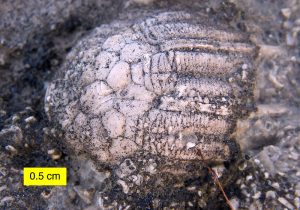The Phylum Echinodermata is upon us. These organisms could be from Mars if we didn’t know better. You will first want to visit the fantastic echinoderm page of the Tree of Life Project. (Friend of the department Bill Ausich of OSU is a member of the Tree of Life echinoderm team.) I find the images on the Animal Diversity Web for echinoderms page (University of Michigan) to be useful. There are numerous websites for specific echinoderm groups. The best I’ve found include ophiuroids, echinoids, the crown-of-thorns starfish, and the Wikipedia page on crinoids. Also check out this nice page on the Carboniferous Crawfordsville crinoids — some of the best in the world. This echinoderm webpage by Teresa Zubi is a lot of fun. (Well, OK, some fun.) This clip of a “sea pig” (Scotoplanes — a holothurian) in deposit-feeding action is a classic. And as a preview of what you are going to do in the lab next week, a video of a sea star dissection! Great music, I must say. And you won’t see echinoderms the same ever again after watching this time-lapse video from Antarctica. Creepy, but they get their own from the Icicle of Death. And why are all these sea urchins going to the same place with such grim determination? Jonathan Bird’s Blue World has a video on sea stars that is entertaining. Here’s a nice Japanese clip on sand dollar moving and feeding, and here’s a hauntingly beautiful Brazilian production on the reproduction and development of a sea biscuit.
On Tuesday, November 21, by 8:00 a.m., your field trip reports are due on paper to me. I’m sure you haven’t forgotten.
Your final two quizzes (#11 and #12) will be “superquizzes” with lots of extra credit. Quiz #11 will be fill-in-the-blank questions from the first half of the course (through bryozoans); quiz #12 from the second.

Eucalyptocrinites calyx; Kaugatuma Formation (Upper Silurian, Pridoli), Saaremaa, Estonia. Specimen found by Nick Fedorchuk.
Geology in the News –
There is a new and interesting argument that the Late Cretaceous asteroid hit just the right spot to cause the global extinctions. The hypothesis is that striking an area rich in petroleum injected massive amounts of soot into the atmosphere that further cooled climate. There will be debates soon over this.
The end-Cretaceous Chicxulub Crater is in the news as scientists publish the results of a drilling expedition into it. They have supporting evidence for why this crater has a peak ring that is unique on Earth but common elsewhere in the Solar System. There are cool images in the version of the story from The New York Times.
The BBC has a separate story on the drilling results that includes a cool animated model of how the Chicxulub Crater was formed. There were for a few minutes mountains as high as the Himalayas!
How long did it take for life to recover from the Cretaceous extinctions? New studies suggest about four million years, but up to nine million years in North America, which was hit hardest.
